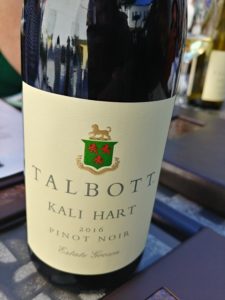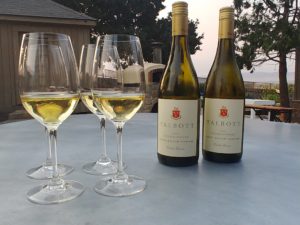 America is a crazy experiment when it comes to mixing a diversity of races and ancestries without one distinctive culture uniting all of us. It is messy, chaotic and just plain scary at times… the fierce, in your face, clashes we have and the constant debate over ‘where does freedom of expression end and the safeguard of a society begin’ seems to never resolve itself. These thoughts were intensified by a documentary I saw recently that addressed the last years of the life of Dr. Martin Luther King Jr – a beloved American civil rights leader who, according to his closest friends and colleagues, was a great man who had his own moments of doubt and conflict.
America is a crazy experiment when it comes to mixing a diversity of races and ancestries without one distinctive culture uniting all of us. It is messy, chaotic and just plain scary at times… the fierce, in your face, clashes we have and the constant debate over ‘where does freedom of expression end and the safeguard of a society begin’ seems to never resolve itself. These thoughts were intensified by a documentary I saw recently that addressed the last years of the life of Dr. Martin Luther King Jr – a beloved American civil rights leader who, according to his closest friends and colleagues, was a great man who had his own moments of doubt and conflict.
Talbott Vineyards
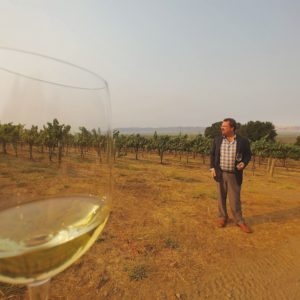 It was serendipitous that I would find myself in the Talbott Vineyards cellar with winemaker David Coventry talking about the brighter future of Talbott based on a new Pinot Noir which co-ferments 3 different types of clones instead of fermenting each different clone separately and then blending them together… this wine was the only one that could be co-fermented successfully, in David’s opinion, because it was from the best grapes that were all ready at the same time.
It was serendipitous that I would find myself in the Talbott Vineyards cellar with winemaker David Coventry talking about the brighter future of Talbott based on a new Pinot Noir which co-ferments 3 different types of clones instead of fermenting each different clone separately and then blending them together… this wine was the only one that could be co-fermented successfully, in David’s opinion, because it was from the best grapes that were all ready at the same time.
Co-Fermentation
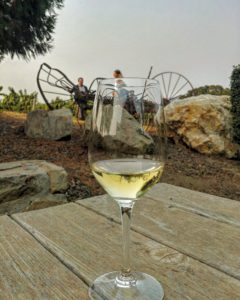 Co-fermenting grapes, not only from different clones but from different varieties, is not a new practice; actually it is an ancient one. It was common for small producers in traditional winemaking countries, such as Italy, to have a “field blend” of varieties that were drastically different – even with red and white varieties – and wine producers would pick them all together and toss them all into a vessel to ferment together. As one can imagine, this was more for practical purposes for struggling producers who were just working with the hodgepodge of grape vines that were planted by the previous generations – many of them not even identified. Also, another reason for co-fermentation was due to the idea that one variety seemed to help out a weakness of another while it went through the process.
Co-fermenting grapes, not only from different clones but from different varieties, is not a new practice; actually it is an ancient one. It was common for small producers in traditional winemaking countries, such as Italy, to have a “field blend” of varieties that were drastically different – even with red and white varieties – and wine producers would pick them all together and toss them all into a vessel to ferment together. As one can imagine, this was more for practical purposes for struggling producers who were just working with the hodgepodge of grape vines that were planted by the previous generations – many of them not even identified. Also, another reason for co-fermentation was due to the idea that one variety seemed to help out a weakness of another while it went through the process.
It was interesting to hear David talk about the idea of co-fermentation as the ideal way of making a Pinot Noir when dealing with high quality grapes that reached a balanced state all at the same time. As some of you California wine lovers may already know, Talbott Vineyards is known for raising the identity of the Monterey area as a high quality winemaking AVA (American Viticultural Area) and so its reputation is set, but bringing on David Coventry as the head winemaker, a man who believes in upping the bar for excellence everyday, a couple years ago is a signal that Talbott has many more achievements in the wine world to come… it is exciting to think what the future holds.
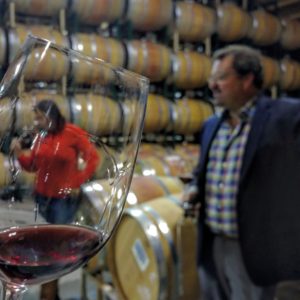 I was lucky enough to get a tiny preview of their future with David as he tasted us on various barrels of Chardonnay and Pinot Noir in their cellar. When it was Pinot Noir time, he saved the most thrilling for last and that was a wine, the name of it not determined yet, that had the 3 different clones co–fermented as discussed above. As we tasted it, I was blown away… it had everything… intense aromatics, fleshy fruit, lush body, elegant structure and fresh acidity, and then as the finish wafted around in my head, I could hear David explain that it was on another level from the other samples because of the “unified flavor set”.
I was lucky enough to get a tiny preview of their future with David as he tasted us on various barrels of Chardonnay and Pinot Noir in their cellar. When it was Pinot Noir time, he saved the most thrilling for last and that was a wine, the name of it not determined yet, that had the 3 different clones co–fermented as discussed above. As we tasted it, I was blown away… it had everything… intense aromatics, fleshy fruit, lush body, elegant structure and fresh acidity, and then as the finish wafted around in my head, I could hear David explain that it was on another level from the other samples because of the “unified flavor set”.
Better Ability to Co-Ferment
David went on to discuss that what made this 3 clone co-fermented wine possible was Talbott’s project to replant old vines with better clones that were appropriate for each plot. His response to people who are horrified that they are taking out the old vines: “What is important is the piece of ground and how you respect it and focus its power.”
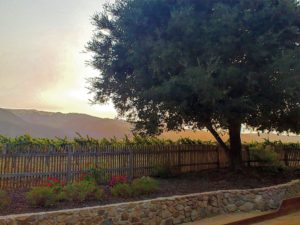 It is interesting when I travel to other countries, and I love to travel, that some people I meet express how terrifying the US seems from the various news clips of the innumerable clashes and they feel sorry for me to be living in such a place. But honestly, I would not want to have been born in any other country because, despite knowing all the tough issues we face on a daily basis, I would never have had the opportunity to be exposed to a multitude of ways of life, mindsets, or expressions of being if I had not been born and continued to live my 43 years here. There is a price for everything and the hard road of trying to create a world where everyone freely expresses their true inner self is the road that I will choose every time. But I do think we can have our own successful co-fermented moments… when we are surrounded by people who decide to be their best and we are all at that ideal, balanced place in our life. Those are the moments that kept Dr. King going and those moments will keep hope alive for all of us.
It is interesting when I travel to other countries, and I love to travel, that some people I meet express how terrifying the US seems from the various news clips of the innumerable clashes and they feel sorry for me to be living in such a place. But honestly, I would not want to have been born in any other country because, despite knowing all the tough issues we face on a daily basis, I would never have had the opportunity to be exposed to a multitude of ways of life, mindsets, or expressions of being if I had not been born and continued to live my 43 years here. There is a price for everything and the hard road of trying to create a world where everyone freely expresses their true inner self is the road that I will choose every time. But I do think we can have our own successful co-fermented moments… when we are surrounded by people who decide to be their best and we are all at that ideal, balanced place in our life. Those are the moments that kept Dr. King going and those moments will keep hope alive for all of us.
As younger generations evolve to the next stage, like the old vines getting replanted by newer vines that have a better ability to co-ferment, our diverse society will have more of those ideal moments of co-fermentation.
*********************************************************************
Tasting of Talbott Vineyards Wines on August 6th & 7th, 2018
 –2016 ‘Kali Hart’, Chardonnay, Monterey AVA, California: 100% estate grown Chardonnay. The ‘Kali Hart’ wines are Talbott’s most fruit-forward expression of their Sleepy Hollow Vineyard. This wine was everything that one wants from their weekly Chardonnay with lush exotic fruit that was balanced by bright citrus peel with a sense of place on the finish. A truly delightful wine that hits the spot every time.
–2016 ‘Kali Hart’, Chardonnay, Monterey AVA, California: 100% estate grown Chardonnay. The ‘Kali Hart’ wines are Talbott’s most fruit-forward expression of their Sleepy Hollow Vineyard. This wine was everything that one wants from their weekly Chardonnay with lush exotic fruit that was balanced by bright citrus peel with a sense of place on the finish. A truly delightful wine that hits the spot every time.
–2016 ‘Kali Hart’, Pinot Noir, Monterey AVA, California: 100% estate grown Pinot Noir. Sometimes it can seem impossible to find a very nice Pinot Noir at a reasonable price… but this ‘Kali Hart’ will not break the bank to buy a bottle. Talbott winemaker David Coventry said that all of us have a section in our brain marked “yum” and this wine “pushes that button”. Ripe raspberry with baking spice and hint of Tahitian vanilla bean with a texture that felt like ribbons of silk.
–2016 Sleepy Hollow Vineyard, Chardonnay, Santa Lucia Highlands AVA, California: 100% estate grown Chardonnay. The Sleepy Hollow vineyard brought attention to well-made wine from Monterey, especially from the sub-appellation Santa Lucia Highlands and Talbott is the producer who started it all. This Chardonnay was laced with intense minerality that had lemon curd flavors that brought a creamy quality balanced by vigor that finished with a touch of marzipan.
 -2016 Sleepy Hollow Vineyard, Pinot Noir, Santa Lucia Highlands AVA, California: 100% estate grown Pinot Noir. I love, love this wine and I must admit I have a weakness for great Pinot Noir. Multi-layered wild red berries with a lush body that had a firmer structure than the 2015 below. It had an incredible depth of flavor and complexity with plum pie and nutmeg flavors that had hints of gravelly earthiness and it was stunning in its superb length of flavor.
-2016 Sleepy Hollow Vineyard, Pinot Noir, Santa Lucia Highlands AVA, California: 100% estate grown Pinot Noir. I love, love this wine and I must admit I have a weakness for great Pinot Noir. Multi-layered wild red berries with a lush body that had a firmer structure than the 2015 below. It had an incredible depth of flavor and complexity with plum pie and nutmeg flavors that had hints of gravelly earthiness and it was stunning in its superb length of flavor.
 -2015 Sleepy Hollow Vineyard, Pinot Noir, Santa Lucia Highlands AVA, California: 100% estate grown Pinot Noir. The 2015 had higher toned wild berry notes than the 2016 that were delicate and pretty in a more ethereal experience. A light and nimble wine that caught me off guard having power in its staying power as it danced in my head all night long.
-2015 Sleepy Hollow Vineyard, Pinot Noir, Santa Lucia Highlands AVA, California: 100% estate grown Pinot Noir. The 2015 had higher toned wild berry notes than the 2016 that were delicate and pretty in a more ethereal experience. A light and nimble wine that caught me off guard having power in its staying power as it danced in my head all night long.
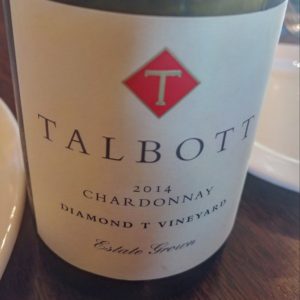 –2014 Diamond T Vineyard, Chardonnay, Monterey AVA, California: 100% estate grown Chardonnay. The Diamond T 14-acre (6 hectares) vineyard was planted with the Corton-Charlemagne Chardonnay clone in 1982 by Robb Talbott in a virtually soil-free chalky shale on a 1,200-foot mountaintop (366 meters). A lovely citrus blossom nose with hints of acacia and chalky soil that had lots of finesse and energy on the palate with marked acidity and fresh lemon flavors that were balanced with a creamy body along the long, pure finish.
–2014 Diamond T Vineyard, Chardonnay, Monterey AVA, California: 100% estate grown Chardonnay. The Diamond T 14-acre (6 hectares) vineyard was planted with the Corton-Charlemagne Chardonnay clone in 1982 by Robb Talbott in a virtually soil-free chalky shale on a 1,200-foot mountaintop (366 meters). A lovely citrus blossom nose with hints of acacia and chalky soil that had lots of finesse and energy on the palate with marked acidity and fresh lemon flavors that were balanced with a creamy body along the long, pure finish.
–2014 Diamond T Vineyard, Pinot Noir, Monterey AVA, California: 100% estate grown Pinot Noir. From the Diamond T vineyard as well from a selection of Dijon clone grapes. This is a cool climate, producing aromatically complex Pinot Noir that is balanced by low yields for deeper concentration. At first, this wine was brooding with black cherries and scorched earth notes but it transformed in the glass with cinnamon bark, fresh cranberries and a stony minerality that danced on the top of the darker, more sultry, flavors. The velvety texture combined with the complex, dense and bright notes made this a world class show stopper that continued all its delights along an extremely long and expressive finish.

